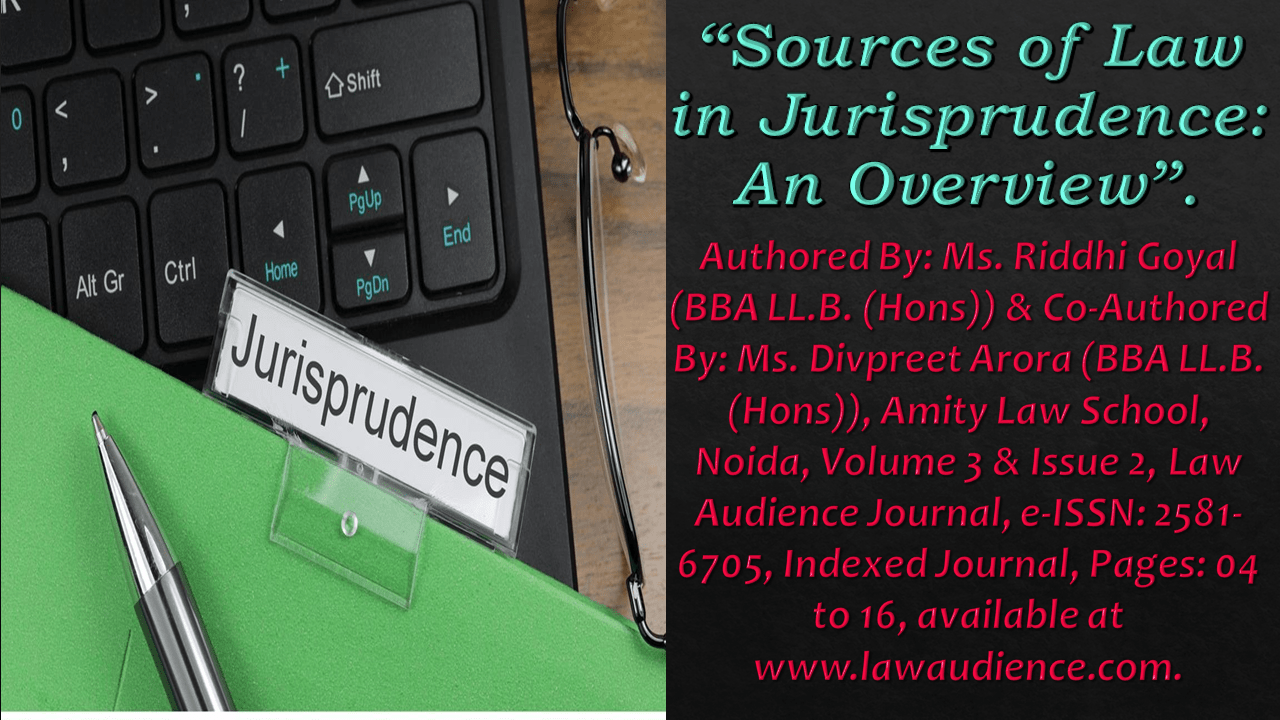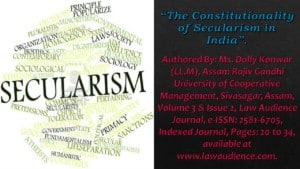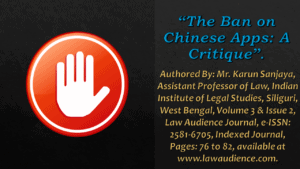Click here to download the full paper (PDF)
Authored By: Ms. Riddhi Goyal (BBA LL.B. (Hons)) & Co-Authored By: Ms. Divpreet Arora (BBA LL.B. (Hons)), Amity Law School, Noida,
Click here for Copyright Policy.
ABSTRACT:
“Every civilisation consists of law and order and in order to understand the law, one has to study about where it came from or the origin of the law, in other words, sources of law. There is no single definition to what are the sources of law. The general meaning of ‘source’ is ‘origin’. The expression “Sources of law” may mean the origin from which rules of human conduct came into existence and derived its legal force or binding character. Sources of law have been interpreted in many ways by different jurists due to the difference of opinion amongst them.
According to some jurists, the source of law is the society itself whereas some believe it to be the will of the sovereign. For instance, according to Austin, the sovereign is the most important source of law[1] while Savigny and Henry Maine consider custom as the most important source of law[2]. Even after a lot of confusion and contradictions, it is believed that in almost all societies, the law has been derived from a similar source. In this paper, we will be discussing the sources of law in detail with their classifications. We will be explaining the sources and their classification through the point of view of different jurists.
In the end, we will be throwing some light on the landmark cases related to the sources of law”.
I.CLASSIFICATION OF SOURCES:
Salmond, an English Jurist has divided the sources of law into two major categories[3]:
I.I Formal Sources:
These are the sources from which law derives its force and validity. For example, a law enacted by the state or the sovereign.
I.II Material Sources:
These refer to the various processes which result in the evolution of the materials which are the constituents of laws. In simpler words, it is all about the matter from which the law has been derived and not the validity.
Material sources are further divided into two parts:
I.II.I Legal:
These are recognised by the law itself as authoritative. They operate immediately, i.e, they are the immediate sources of law. The law which comes from the legal source is divided into three categories:
- Customary Law (Customs),
- Case Laws (Precedents),
- Statute Law (Legislations),
I.II.II Historical:
These are unauthoritative, i.e., they have no binding force and are not recognised by the law. These operate indirectly or mediately. They may become legal if they are recognised by law as such or when they are incorporated in law. For example, Jurists’ writings, literary work and Foreign decisions.
II. CRITICISM OF SALMOND’S CLASSIFICATION:
The classification of Sources of Law done by Salmond has been criticized by many Jurists time and again.
Allen[4], criticised Salmond for not throwing much light on the historical sources of law. According to Allen, Historical sources of law carry a lot of weight and should be given more importance. Keeton[5], too has criticized the classification done by Salmond. He says that, “in modern times, the only formal source of law is the state, but the state is an organization enforcing law”. Therefore, according to Keeton, technically, the state cannot be considered as a source of law.
III. SOURCES OF LAW:
III.I FORMAL SOURCES OF LAW:
Varied sources have been recognised as a valid source of law since the establishment of society and these sources have been classified into formal and informal sources of law. Formal Sources of Law has laid down three valid sources, from where the law derived is entrusted upon and which encompasses validity.
III.I.I Will of the State:
State is the primary trusted authority when it comes to authenticated and verified laws. They are seen as a valid authority as they are concerned with the governance of the nation. The main aim of the laws formulated by the State is to ensure peace and tranquillity in the nation and it is not driven by any ill motive which makes those laws more trustable. Though the will of the nation might have a different outcome in the different political structure like the nation where dictatorship prevails, the statutes formulated might not be in the favour of the people whereas in the democratic nation, the will of the state is mostly drawn towards public’s welfare.
In India, 7th Schedule comprises two lists stating the responsibilities of Union government and State Government in the Union List and State List respectively. Accordingly, both the governments can make laws on the subjects allocated under their respective lists.
III.I.II Will of the People:
Laws are meant to fulfil the requisite demand of the people of the nation. Whenever new impediments or problems fall before people which need urgent redressal then the state after valid ratification can approve such demand into law. Will of the people as a source of law is mainly dominant in a democratic nation where the voice of people is the prime consideration and of optimum concern of the law making authority. Thus, will of the people always compel the authorities of the state to formulate laws in their favour and people often support those governments who are ready to transform people’s will into statute.
For example, Women at the workplace were facing immense sexual exploitation and they showed their angst through various platforms and eventually government recognised the people’s concern and formulated Sexual Harassment of Women at Workplace (Prevention, Prohibition and Redressal) Act, 2013.
III.I.III Judicial Decision of the Court or the Precedents:
There is no second thought to the fact that Judiciary is one of the strongest pillars on whom we can depend upon to seek laws. Judicial Decision or Precedents are those judgements of the courts which have taken the shape of laws over a period of time. Unless and until any concrete evidence or facts are presented against such precedent set up by the court, the decision will be treated as an established law forever.
It is also important to understand the concept of Ratio-decidendi which means the reason for the decision, Judiciary lays down the reason behind its judgement and it answers all the concerns which arise, making the law more authentic. Judiciary also play a very important role in assisting the state to formulate laws and such laws turn out to be more definite and reliable.
The above-mentioned sources of law are formal sources who contribute in formulating a strong and concrete legal system.
III.II MATERIAL SOURCES OF LAW:
The material sources of law are those which gives the matter or content of a principle of law. As the word material suggests, these sources deal with the subject matter and content of the law. In simple words, the material sources of law tell us what the law contains. It is divided into two categories:
III.II.I Legal Material Sources: (Authoritative Law):
These are mainly divided into 3 categories:
III.II.I.I Customs: (Customary Law):
It is said that customs are the most important source of law and in some cases, it is said that it is the sole source of law. Custom is the most ancient of all sources of law. It held the most important place in the past though with changing times it is diminishing and legislations and judicial precedents are gaining more importance.
A custom is a habitual course of conduct observed uniformly and voluntarily by the society. It is said that no custom shall have the force of law if it violates the fundamental rights. There are different and divergent views on the origin of customs.
III.II.I.I.I Importance of Customs:
- It provides the material out of which the law can be fashioned because it usually takes a great deal of intellectual effort to create a completely new law.
- It is easier to secure respect for law which is based on customs.
III.II.I.I.II Classification of Customs:
Customs in their wider sense can be classified into two classes:
III.II.I.I.II.I Customs without sanction:
These are the non-obligatory customs. They are observed due to pressure of the public. Austin termed these are “positive morality”.
III.II.I.I.II.II Customs having sanction:
These are obligatory and are enforced by the state. They may be legal or conventional. Legal are the ones which operate as a binding rule of law whereas the conventional customs are those which govern the parties to an agreement.
III.II.I.I.III Essentials of a Valid Custom:
There are some essentials for a custom to be valid. These were laid down by Blackstone to which most of the jurists agreed[6].
- Antiquity: A custom to be recognised as law must be proved to be in existence from time immemorial. Time immemorial as per English Rule is it should be practiced from anytime before 1189 but there is no time given in the Indian rule.
- Reasonableness: A custom must be reasonable in order to become a law. This is considered to be the toughest test for a custom to pass as certain standards are established for the courts to proceed. A general observation of a custom leads to the presumption that it has a rational basis and that is useful and convenient. Reasonableness of the custom will not lead it to become a law but unreasonableness of a custom will definitely abstain it from becoming a law.[7]
- Continuous Observance: It must be practiced continuously without any changes, from time immemorial. In the case of Baba Narayan vs. Saboosa[8], it was held that for a custom to become a valid custom, it is not just important to be in existence from time immemorial but continuous.
- Certainty: A custom to be a valid one must be certain. A custom which is vague or indefinite cannot be recognised.
- Consistency: Any custom must not come into conflict with the other established customs. There must be consistency among the customs.
- Conformity With Statute Law: A custom, to be valid, must be in conformity with the statute law.
III.II.I.I.IV When does a Custom become Law?
Two views have been given on this.
i. Analytical View:
Austin said that customs are not law until so declared by the sovereign and Gray said that customs are not law until approved by the judge.
ii. Historical View:
Savigny; Puchta says that declaration or recognition by the state is not necessary. It means that if a custom has been made, there would be a strong need of it.
III.II.I.II Precedents:
There is a judicial organ in every developed legal system to adjudicate the rights and obligations of the citizens. A number of jurists have defined the term precedents in their own way. Gray defined precedents as, “A precedent covers everything said or done, which furnishes a rule for subsequent practice’.[9] A judicial precedent is considered to be one of the most important sources of law. It means a previous instance or a case that is either binding or persuasive for a court when deciding a subsequent case with similar facts. The principle by which the judges are bound to precedence is called Stare Decisis which means to stand by the decision. A binding precedent is where previous decisions must be followed. It is created when the facts of a latter case are sufficiently similar to the facts of a former case.
III.II.I.II.I Importance of Precedents:
Precedents have been an important source of law since ancient times. Precedents make it easier for the judges to decide the case as per the previously given judgments on the similar cases.
III.II.I.II.II Doctrine of Precedents:
The doctrine of precedents is often considered to be a very rigid doctrine within the court hierarchy, every court is bound to the previously made decisions by the courts higher than them. Secondly, to a certain extent, the higher courts are bound by their own decisions.
III.II.I.II.III The operation of the doctrine:
The Supreme Court:
In India, at the very top of the hierarchy is the Supreme Court followed by the High Courts and the District courts at the lowest level. Supreme Court is the highest court in India, its decision is binding on all the courts within the territory of India.
The High Courts:
Decisions given by the High Courts are binding on all the District Courts within its jurisdiction.
As regards High Courts, they are to a certain extent bound by their own decisions. The Apex Court, i.e., The Supreme Court, in the famous cases of Kesavananda Bharati vs. State of Kerala[10], and I.C. Golaknath and Ors. vs. State of Punjab and Anrs.[11], proved that it is not bound by its own decisions. The facts of these two cases were similar but the judgment was totally opposite.
In Pillani Investment Corporation vs. T.I Officer, Calcutta,[12] it was shown that the earlier judgment of the Supreme court is erroneous or that any vital point was not considered, the Supreme court will decline to review its earlier judgment.
III.II.I.II.IV Doctrine of ‘Stare Decisis’:
- “To stand by decisions and not to disturb settled matters.’
- Based on public policy and expediency, i.e, fast decision making if based on previous judgments.
- It secures the certainty and predictability.
- The rule of stare decisis is not an inflexible rule.
- The decision of following it or departing is within the discretion of the Supreme Court.
In the case of Sangham Tape Co. vs. Hans Raj[13], it was held that a fact situation obtaining in one case cannot be said to be a precedent for another case.
Application of the Doctrine of precedents:
The authority of a decision as a precedent lies in its ratio decidendi.
III.II.I.II.V Ratio Decidendi:
- It is the reason behind the decision.
- The decision of the court is based on:
- What does the case decide between the parties?
- What principle of rule of law does it lay down?
- In delivering judgments, the judge gives reasons behind his judgment, and it is these reasons which may be important as precedents.
III.II.I.II.VI Obiter Dictum/Dicta:
- These are the remarks of a judge which are not necessary to reaching a decision, but are made as comments or illustrations.
- They are usually incidental and are not binding persuasive authority.
- It is the general observation of the judge and do not have a binding authority.
III.II.I.III Legislation:
The word Legislation has been derived from the two Latin words “legis” which means law and “Latum” which means making and together they mean law making. Therefore, the word Legislation means the process of law making. Legislation is that source of law which consists in the declaration of legal rules by a competent authority.
In modern times, legislation is the most potent source of law.
- It lays down the rules by the legislature which the state recognises as law.
- It has the force and authority of the state.
- Legislation mostly becomes the exclusive source of law with the advancing citation. The power of the Supreme Legislation of Indian parliament is strictly defined in the constitution.
According to Austin, legislation includes activities which result into law making or inserting new provisions in the existing law. Thus, a law without a legislative act is impossible[14]. The power of legislation vests in the sovereign authority of a political community.
III.II.I.III.I Types of Legislation:
Legislations are of two major types; direct or indirect. A legislation is direct when the sovereign authority itself makes the law, as the law as the law made by the Indian Parliament and it is indirect when the powers to make laws are delegated by the sovereign authority to any other authority. The direct legislation is known as the Supreme legislation whereas indirect legislation is known as the Subordinate legislation.
III.II.I.III.I.I Supreme legislation:
Legislation is supreme when it proceeds from the sovereign and is incapable of being annulled or controlled by any other legislative but the sovereign is bound by the law too. It is the law which decides the identity and the composition of the sovereign. It also tells the procedure according to which the sovereign is to legislate. Also, the areas in which the sovereign is to legislate.
III.II.I.III.I.II Subordinate legislation:
Subordinate legislation proceeds from any other authority other than the sovereign power. It is dependant for its continued existence and validity on some supreme authority. In India, the parliament is sovereign but not supreme although it possesses the power of supreme legislation. In India, the constitution is considered to be the supreme. Hence, the parliament is subject to constitutional limitations. Subordinate legislation is enacted under the delegated authority of the sovereign.
Subordinate Legislations are of many kinds like:
1. Colonial Legislation: The British colonies were conferred limited power of self-government in varying degrees by the imperial legislature. The colonies enjoyed limited power of law making but the laws so made could be repealed, altered or super seeded by the imperial legislature (British parliament). Basically, laws made by the colonial countries for their colonies are known as colonial laws.
2. Executive Legislation: The Legislature that is the parliament often delegates its rule making power to certain departments of the executive organ of the government. The rules made in pursuance of this delegated power have the force of law. However, they can be repealed, altered or super seeded by the legislature.
3. Judicial Legislation: In certain cases, the legislative power of rule making is delegated to the judiciary and authorisation to make rules for regulation of their own procedure in the exercise of their power is delegated upon the superior court. The Indian Constitution has given the power of rule making to the Apex court under Article 145 and to the High courts under Article 227. Limitations for judiciary in law making are:
- They should be under the law enacted by the parliament.
- The approval of the President is necessary for such rules.
4. Municipal Legislation: The Municipal authorities are allowed to make bye-laws for limited purposes like water tax. They are allowed to exercise the power only within their areas.
5. Autonomous Legislation: The state may occasionally allow private bodies or entities such as universities, companies etc to make bye-laws for regulating the conduct of their business.
III.II.I.III.I.II.I Validity of Subordinate Legislation:
In order to make the delegated legislation power valid, these are the certain conditions that must be satisfied:
- The parent act must be valid.
- The delegation clause in the parent act must be valid.
- The statutory instrument so made must be in conformity with the delegation clause.
- It must not violate any of the fundamental rights or any other provision laid down in the constitution.
III.II.I.III.I.III Delegated Legislation:
It means legislation made by bodies other than the legislature. The term ‘delegated legislation’ is commonly used in two senses:
- It means the exercise of rule making power by the executive under the authority delegated to it by the legislature.
- It means the output of the exercise of that power in the form of rules, regulations, bye-laws and orders etc.
III.II.II Historical Material Sources:
Historical or Informal sources of law are considered questionable as till date it hasn’t got any formalized recognition by the law. These are mostly implied in an indirect and tortuous manner. They impact pretty much broadly the course of lawful development, yet they talk with no power.
III.II.II.I Equity:
Equity is a principle which shall govern each and every law and eventually becomes one of the primary sources of law. It is one of the principles on which the natural laws have been based upon and it also lay down the requisites before law making authorities before passing any law. Equity governs the principle where no one would be treated in a discriminating manner and the law passed on the lines of equity must pass the criteria of equality, Justice and good conscience. In the event that there is a contention among value and law, it is the law which must win. Equity can enhance the law when there is a hole in it, otherwise not.
III.II.II.II Conventions:
We often come across various international submits being organized in different countries on varied topics. In these submits countries often sign-up certain Conventions, contractual relations, and treaties which are bilateral or multilateral in nature.
The documents which are signed upon creates obligation over the contracting parties to follow the rules laid down in such document. These conventions often lead to formulation of conventional law. For example- If a convention is ratified by India its contents and terms become binding on the Indian Legal System.
IV. CONCLUSION:
The law generally comes from all the sources which are explained above. Legislation, Precedents and Customs may be regarded as the binding sources, and the rest as persuasive. We have discussed the sources of law and the classification of sources interpreted by different jurists and in different case laws.
References & Footnotes:
[1] Austin’s Theory of Sovereignty (Monistic View), available at https://www.brainkart.com/article/Austin-s-Theory-Of-Sovereignty-(Monistic-View)_1626/.
[2] Custom As A Source of Law, available at http://law.uok.edu.in/Files/5ce6c765-c013-446c-b6ac-b9de496f8751/Custom/Uni-5.pdf.
[3] Sources of Law, available at https://ccsuniversity.ac.in/bridge-library/pdf/LLM-2904-II-SEM-JURISPRUDENCE-II-L-2002-Lecture-on-Sources-of-Law-&-Custom.pdf.
[4] Ibid.
[5] Ibid.
[6] What are the essential elements of a valid custom?, available at https://www.preservearticles.com/education/what-are-the-essential-elements-of-a-valid-custom/18176.
[7] Ram Dhan Lal and others vs. Radhey Shyam, 1951 AIR 210, 1951 SCR 370.
[8] (1943) 2 MLJ 186 (189).
[9] The Nature and Sources of Law.
[10] (1973) 4 SCC 225; AIR 1973 SC 1461.
[11] 1967 AIR 1643; 1967 SCR (2) 762.
[12] A.I.R 1972 S.C 236.
[13] (220) 9 SCC 331.
[14] supra note 1.
Cite this article as:
Ms. Riddhi Goyal & Ms. Divpreet Arora, Sources of Law in Jurisprudence: An Overview, Vol.3 & Issue 2, Law Audience Journal (e-ISSN: 2581-6705), Pages 04 to 16 (9th August 2021), available at https://www.lawaudience.com/sources-of-law-in-jurisprudence-an-overview/.



